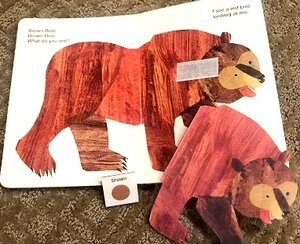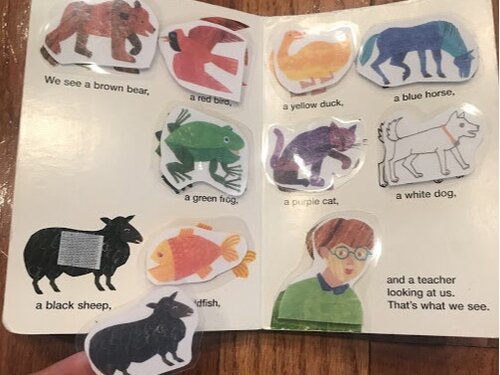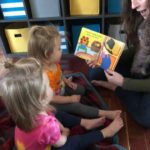Books have been an essential part of our therapy sessions for years! Young children’s books often have a rhyme or rhythm like a song that catches their attention. It is only when we catch our little one’s attention that learning takes place! Some of these books are repetitious with predictable phrases, making it easier to remember the words so that they can eventually “read” the book to you. These books often lend themselves to performing actions, which is also key to catching the child’s attention so that they enjoy what they’re doing, have success doing it, and ultimately do it again and again!
Keep in mind that children like to be played with and entertained. It is important that as you read these books, you are animated with your voice and facial expressions. After all, books can be fun!
Here are 10 favorite books that we like to use with our little friends & tips for how they can be used in therapy and at home:
Blue Hat, Green Hat by Sandra Boynton: This book has basic colors & common clothes labels (e.g., shoes, hat, shirt) that are referred to throughout the book. These two words (color word + clothing item) promote two word utterances over and over. At the end of each page the word “oops!” is used (Pro Tip: substitute the word “uh-oh” as this is often more prevalent in a child’s early vocabulary). Use facial expressions and dramatic inflections in your voice to keep the child’s attention and keep a rhythm as you read the book.
Brown Bear, Brown Bear, What Do You See? by Bill Martin Jr/Eric Carle: Love this one so much! And there are several different forms—slide flap board book, board book, hard back. See the photo below for an idea adapted specifically for children that have a hard time attending. As you can see, we simply color copied & laminated part of the picture so that the child could interact with the book as we are reading. In addition, we added a color icon for each corresponding page so that it lends itself to producing two word phrases for those children that are at that level. With this adaptation, you can work on skills such as matching, identifying, and labeling. This book format has also been duplicated by teachers and therapists on sites such as Pinterest or Teachers Pay Teachers that can be printed and laminated for your use (White Ghost, White Ghost, What Do You See?; Santa Santa, What Do You See?; Pumpkin, Pumpkin, What Do You See?).


My Nose, My Toes and Me! by Frida Bing/Rachael O’Neill (lift the flap board book): This is a great body part teaching book that is interactive. To target imitation of actions you can also pretend to smell the flower, eat a cookie, and use your hands to splash in the water!
All Better by Usbourne Books: A new favorite this year! It comes with band-aids that you actually put on each animal’s boo boo in the book! The repetitive phrases “clean it, kiss it, put a bandage on it,” “all better!,” and “ouch!” are modeled throughout the book.

Illustrated actions to the Teddy Bear rhyme. This is great for wiggly kiddos!
Teddy Bear Teddy Bear, illustrated by Michael Hague (action rhyme board book): This book has a page at the end that can be given to families so that they can continue to carry over this action rhyme at home without the book.
Five Little Monkeys Jumping on the Bed by Eileen Christelow: This repetitive and rhythmic book is full of possibilities. You can act it out and/or use props! As with other books, the child can eventually “fill in the blank” where the repetitive phrase is. Practice making pauses during these spots in the book and see if your child attempts to say any part of the phrase.
Goodnight Moon by Margaret Wise Brown/Clement Hurd: Repeats “goodnight” throughout the book (Pro Tip: substitute “Night night” for new talkers to make it easier to repeat!). We have adapted a board book copy similar to Brown Bear. Pro Tip: use additional sounds (e.g., moo, meow, squeak, knock-knock) and words (e.g., hot, circle, pop, up, hands, gloves, eat) throughout the book to describe and/or add to the vocabulary in the book.
Moo, Baa, La La La! by Sandra Boynton: Silly rhyming book that focuses on animals and the sounds they make. I also adapted this book by copying pictures, laminating, and adhering velcro.
Peek a Who? by Nina Lade: This repetitive book has the carrier phrase “Peek A…” on every page with holes in the pages that provide a “peek” into what is on the next page. You can follow up with the “Peek-a-Boo” game for added practice with this phrase and added actions!
Where’s Spot? by Eric Hill (board book/lift the flap): Lift the flap books are great ways to introduce busy toddlers or young children to books because they get to actually DO something while reading the book.
Remember, reading books can be fun, and it is HOW you do it, not WHICH book you choose. You can take any simple book and turn it into an active experience rather than just sitting idle and listening.

